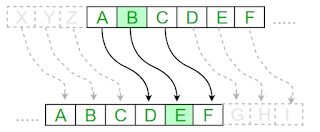
Leon Battista Alberti is credited with creating the first polyalphabetic substitution cipher. Plaintext to ciphertext mapping for the entire message, the substitution alphabet Polyalphabetic substitution ciphers were designed to increase resiliency againstįrequency analysis attacks. Time while “x” occurs only 0.1% of the time). Text (e.g., if “x” occurs 12% of the time, it’s likely to reallyīe an “e” since “e” occurs in English text approximately 12% of the With those that occur with the same frequency in natural language In the general case of the monoalphabetic substitution cipher, a randomly-scrambled substitution alphabet is used but this makes sharing knowledge of the substitution alphabet more difficult.Īre vulnerable to frequency analysis attacks, in which an analystĪnalyzes letter frequencies in ciphertext and substitutes characters

The key is the simply the the shift value: the number n. The simplest of these is the Caesar cipher, known as a shift cipher, in which a plaintext character is replaced with a character that is n positions away in the alphabet. In this cipher, each character of plaintext is substituted with a character of ciphertext based on a substitution alphabet (a lookup table). The earliest practical form of cryptography was the monoalphabetic substitution cipher. Each additional bit in a key doubles the number of possible keys and hence doubles the search time.Ĭlassic cryptography Monoalphabetic substitution ciphers The keys used for encryption should be large enough that a brute force attack is not feasible.Given ciphertext, there should be no way to extract the original plaintext or the key that was used to create it except by of enumerating over all possible keys.Ciphertext should be indistinguishable from random values.We expect algorithms to be publicly known and all security to rest entirely on the secrecy of the key.Ī symmetric encryption algorithm uses the same secret key for encryption and decryption. Kerckhoffs’s Principle states that a cryptosystem should be secure even if everything about the system, except the key, is public knowledge. Knowledge of the key is needed to decrypt the ciphertext. A key is a parameter to a cipher that alters the resulting ciphertext. This has obvious flaws: people in the know leaking the secret, designers coming up with a poor algorithm, and reverse engineering.įor any serious use of encryption, we use well-tested, non-secret algorithms that rely on secret keys. There is no reliance on any key and the secrecy of the cipher is crucial to the value of the algorithm. Nonrepudiation: Binding the origin of a message to a user so that she cannot deny creating it.Ī restricted algorithm is one where the workings of the cipher must be kept secret. Integrity: Validating that the message has not been modified. Authentication Showing that the user really is that user.

Helps build protocols that address: Confidentiality: Hiding the contents of a message. To create ciphertext, which is unintelligible to anyone Computer Security: Paul Krzyzanowski Cryptography Symmetric cryptosystemsĬryptography deals with encrypting plaintext usingĪ cipher, also known as an encryption algorithm,


 0 kommentar(er)
0 kommentar(er)
